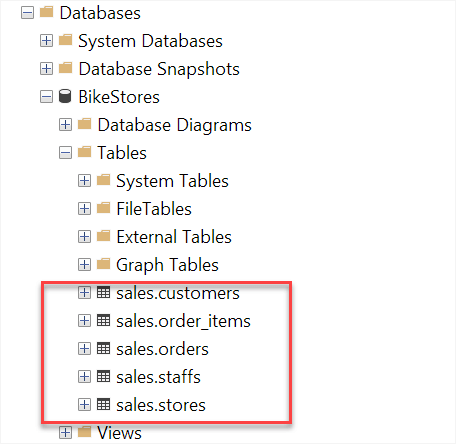Summary: in this tutorial, you will learn about SQL Server Roles and how to assign a user to a role.
Introduction to the SQL Server Roles
A role is a group of permissions. Roles help you simplify permission management. For example, instead of assigning permissions to users individually, you can group permissions into a role and add users to that role:
- First, create a role.
- Second, assign permissions to the role.
- Third, add one or more users to the role.
SQL Server provides you with three main role types:
- Server-level roles – manage the permissions on SQL Server-like changing server configuration.
- Database-level roles – manage the permissions on databases like creating tables and querying data.
- Application-level roles – allow an application to run with its own, user-like permissions.
For each type, SQL Server provides two types:
- Fixed server roles: are the built roles provided by SQL Server. These roles have a fixed set of permissions.
- User-defined roles: are the roles you define to meet specific security requirements.
Adding a user to a role example
First, create a new login called tiger:
CREATE LOGIN tiger
WITH PASSWORD='UyxIv.12';Code language: SQL (Structured Query Language) (sql)Next, switch the current database to BikeStores and create a user for the tiger login:
Use BikeStores;
CREATE USER tiger
FOR LOGIN tiger;Code language: SQL (Structured Query Language) (sql)Then, connect to the BikeStores database using the user tiger. The user tiger can see the BikeStores database but cannot view any database objects.
After that, add the user tiger to the db_datareader role:
ALTER ROLE db_datareader
ADD MEMBER peter;Code language: SQL (Structured Query Language) (sql)The db_datareader is a fixed database role. The db_datareader role allows all the members to read data from all user tables and views in the database. Technically, it’s equivalent to the following GRANT statement:
GRANT SELECT
ON DATABASE::BikeStores
TO tiger;Code language: SQL (Structured Query Language) (sql)In this example, the DATABASE is a class type that indicates the securable which follows the :: is a database. The following are the available class types:
- LOGIN
- DATABASE
- OBJECT
- ROLE
- SCHEMA
- USER
Finally, switch the connection to the user peter and select data from the sales.orders table:
SELECT * FROM sales.orders;Code language: SQL (Structured Query Language) (sql)Creating a user-defined role
The following example creates a new user and role, grants the permissions to the role, and adds a user to the role.
First, set the current database to master and create a new login called mary:
USE master;
CREATE LOGIN mary
WITH PASSWORD='XUjxse19!';Code language: SQL (Structured Query Language) (sql)Second, switch the current database to BikeStores and create a new user called mary for the login mary:
USE BikeStores;
CREATE USER mary
FOR LOGIN mary;Code language: SQL (Structured Query Language) (sql)Third, create a new role called sales_report in the BikeStores database:
CREATE ROLE sales_report;Code language: SQL (Structured Query Language) (sql)In this example, we use the CREATE ROLE statement to create a new role. The sales_report is the role name.
Fourth, grant the SELECT privilege on the Sales schema to the sales_report:
GRANT SELECT
ON SCHEMA::Sales
TO sales_report;Code language: SQL (Structured Query Language) (sql)Fifth, add the tiger user to the sales_report role:
ALTER ROLE sales_report
ADD MEMBER tiger;Code language: SQL (Structured Query Language) (sql)Finally, connect to the BikeStores database using the user mary. In this case, the user mary only can see the tables in sales schema. Also, the user mary can only select data from tables in this sales schema because the user is a member of the sales_report which has the SELECT privilege:

Summary
- A role is a group of permissions.
- Use the
CREATE ROLEstatement to create a new role. - Use the
ALTER ROLE ... ADD MEMBER ...statement to add a user to a role.